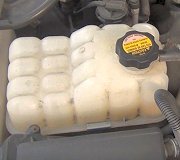Curious, I wanted to see if the system would “burp”, so I fired up the engine with the radiator cap off. After a few minutes, I could see the thermostat had opened, and the first tiny flow of coolant began. However, while the coolant level in the radiator very slowly began to rise, there was no “burp”, no drop in the level within the reservoir.
I allowed the motor to come up to operating temperature, and waited for the electric fan to kick in. By this time, the coolant level in the radiator still hadn’t reached the top, but the reservoir level hadn’t changed. Puzzled, I turned off the ignition, only to be witness the radiator starting to puke coolant out of the top. I’m guessing that, since the water pump was no longer circulating coolant, the residual heat caused the radiator to “burp”, and about a quart of antifreeze ended up on my garage floor. D’OH!
At any rate, can anyone help me understand what may be going on? I mean, the car runs fine and doesn’t overheat, but why on earth would the reservoir be completely full, while the radiator isn’t even *half* full.
Thanks, in advance. : )
Sunday, June 6th, 2021 AT 11:51 AM



